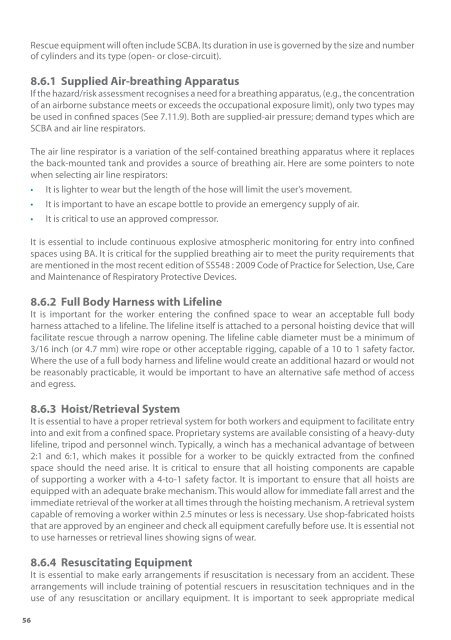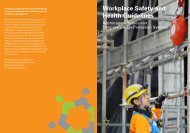Confined Spaces - Workplace Safety and Health Council
Confined Spaces - Workplace Safety and Health Council
Confined Spaces - Workplace Safety and Health Council
- No tags were found...
You also want an ePaper? Increase the reach of your titles
YUMPU automatically turns print PDFs into web optimized ePapers that Google loves.
Rescue equipment will often include SCBA. Its duration in use is governed by the size <strong>and</strong> numberof cylinders <strong>and</strong> its type (open- or close-circuit).8.6.1 Supplied Air-breathing ApparatusIf the hazard/risk assessment recognises a need for a breathing apparatus, (e.g., the concentrationof an airborne substance meets or exceeds the occupational exposure limit), only two types maybe used in confined spaces (See 7.11.9). Both are supplied-air pressure; dem<strong>and</strong> types which areSCBA <strong>and</strong> air line respirators.The air line respirator is a variation of the self-contained breathing apparatus where it replacesthe back-mounted tank <strong>and</strong> provides a source of breathing air. Here are some pointers to notewhen selecting air line respirators:• It is lighter to wear but the length of the hose will limit the user’s movement.• It is important to have an escape bottle to provide an emergency supply of air.• It is critical to use an approved compressor.It is essential to include continuous explosive atmospheric monitoring for entry into confinedspaces using BA. It is critical for the supplied breathing air to meet the purity requirements thatare mentioned in the most recent edition of SS548 : 2009 Code of Practice for Selection, Use, Care<strong>and</strong> Maintenance of Respiratory Protective Devices.8.6.2 Full Body Harness with LifelineIt is important for the worker entering the confined space to wear an acceptable full bodyharness attached to a lifeline. The lifeline itself is attached to a personal hoisting device that willfacilitate rescue through a narrow opening. The lifeline cable diameter must be a minimum of3/16 inch (or 4.7 mm) wire rope or other acceptable rigging, capable of a 10 to 1 safety factor.Where the use of a full body harness <strong>and</strong> lifeline would create an additional hazard or would notbe reasonably practicable, it would be important to have an alternative safe method of access<strong>and</strong> egress.8.6.3 Hoist/Retrieval SystemIt is essential to have a proper retrieval system for both workers <strong>and</strong> equipment to facilitate entryinto <strong>and</strong> exit from a confined space. Proprietary systems are available consisting of a heavy-dutylifeline, tripod <strong>and</strong> personnel winch. Typically, a winch has a mechanical advantage of between2:1 <strong>and</strong> 6:1, which makes it possible for a worker to be quickly extracted from the confinedspace should the need arise. It is critical to ensure that all hoisting components are capableof supporting a worker with a 4-to-1 safety factor. It is important to ensure that all hoists areequipped with an adequate brake mechanism. This would allow for immediate fall arrest <strong>and</strong> theimmediate retrieval of the worker at all times through the hoisting mechanism. A retrieval systemcapable of removing a worker within 2.5 minutes or less is necessary. Use shop-fabricated hoiststhat are approved by an engineer <strong>and</strong> check all equipment carefully before use. It is essential notto use harnesses or retrieval lines showing signs of wear.8.6.4 Resuscitating EquipmentIt is essential to make early arrangements if resuscitation is necessary from an accident. Thesearrangements will include training of potential rescuers in resuscitation techniques <strong>and</strong> in theuse of any resuscitation or ancillary equipment. It is important to seek appropriate medicaladvice before any system is in place for providing resuscitation. At the same time, also take intoconsideration the level of available expertise.Ancillary devices may be needed for oral resuscitation: these avoid direct contact between themouths of the victim <strong>and</strong> rescuer, for example, by using special tubes <strong>and</strong> mouthpieces. However,if resuscitation is needed as a result of exposure to toxic gases, oral methods are not appropriatesince they could put the rescuer at risk. In some cases, equipment for artificial respiration as afollow-up to, or in place of, oral resuscitation is appropriate. It is important for the equipmentto be operated by someone with the necessary specialist training, or it can be kept available,properly maintained, on site for use by a person providing professional medical help.8.6.5 Personal Protective Equipment (PPE)It is essential to conduct a proper assessment of conditions <strong>and</strong> identify work processes thatrequire additional protective equipment for the task to be undertaken. For example, the possibilityof personal exposure to toxic substances <strong>and</strong> traumatic injury requires the consideration of fullbody protection.It is necessary to provide appropriate first aid equipment <strong>and</strong> make available for emergencies. Itis important to have first-aiders trained to deal with the foreseeable injuries.It is essential to maintain <strong>and</strong> inspect all equipment provided for an emergency. Inspection alsoincludes periodic examinations <strong>and</strong> tests according to the manufacturer’s instructions or theappropriate requirements of health <strong>and</strong> safety legislation.The examination of ropes, harnesses, lifelines, protective clothing, <strong>and</strong> other special equipmentwill normally consist of a thorough visual examination of all their parts for deterioration ordamage, in particular, on those parts that are load-bearing. It is necessary for the examinationsto be carried out regularly <strong>and</strong> a record kept of them.It is necessary to acquire certificates of test <strong>and</strong> safe working loads when purchasing liftingequipment, such as ropes, harnesses, lifelines, shackles, <strong>and</strong> so on. It is important to ensure thatthey are not further tested (as this could weaken them). It is necessary to scrap or dispose theequipment if they are damaged. Otherwise, return them to the manufacturer or other competentrepairers who can carry out the necessary remedial work <strong>and</strong> supply a new certification of test<strong>and</strong> safe working load for the repaired equipment.Communication equipment can facilitate a confined space rescue by saving time in relayinginstructions <strong>and</strong> medical information. Reliable communication can have a calming effect onrescuers, leading to a more efficient operation.8.6.6 Availability <strong>and</strong> MaintenanceAs a guide, the following recommendations are good practices:• Equipment placed on-site locations should be checked daily;• Equipment based in the location should be checked on a weekly basis; <strong>and</strong>• Equipment located in storage locations should be checked monthly.56 57
















